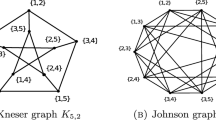Abstract
Several procedures for the identification of facet inducing inequalities for the symmetric traveling salesman polytope are given. An identification procedure accepts as input the support graph of a point which does not belong to the polytope, and returns as output some of the facet inducing inequalities violated by the point. A procedure which always accomplishes this task is calledexact, otherwise it is calledheuristic. We give exact procedures for the subtour elimination and the 2-matching constraints, based on the Gomory—Hu and Padberg—Rao algorithms respectively. Efficient reduction procedures for the input graph are proposed which accelerate these two algorithms substantially. Exact and heuristic shrinking conditions for the input graph are also given that yield efficient procedures for the identification of simple and general comb inequalities and of some elementary clique tree inequalities. These procedures constitute the core of a polytopal cutting plane algorithm that we have devised and programmed to solve a substantial number of large-scale problem instances with sizes up to 2392 nodes to optimality.
Similar content being viewed by others
References
F. Barahona and M. Conforti, “A construction for binary matroids,”Discrete Mathematics 66 (1987) 213–218.
N. Christofides and S. Eilon, “An algorithm for the vehicle-dispatching problem,”Operations Research Quarterly 20 (1969) 309–318.
H. Crowder and M. Padberg, “Solving large-scale symmetric traveling salesman problems to optimality,”Management Science 26 (1980) 495–509.
B.E. Gillett and J.G. Johnson, “Multi-terminal vehicle-dispatch algorithm,”Omega 4 (1976) 711–718.
R.E. Gomory and T.C. Hu, “Multi-terminal network flows,”SIAM Journal on Applied Mathematics 9 (1961) 551–570.
M. Grötschel and O. Holland, “Solving matching problems with linear programming,”Mathematical Programming 33 (1985) 243–259.
M. Grötschel and O. Holland, “A cutting plane algorithm for minimum perfect 2-matchings,”Computing 39 (1987) 327–344.
M. Grötschel, L. Lovász and A. Schrijver, “The ellipsoid method and its consequences in combinatorial optimization,”Combinatorica 1 (1981) 169–197.
M. Grötschel and M. Padberg, “On the symmetric travelling salesman problem II: lifting theorems and facets,”Mathematical Programming 16 (1979) 281–302.
M. Grötschel and M. Padberg, “Polyhedral theory,” in: E. Lawler et al., eds., The Traveling Salesman Problem (Wiley, Chichester, 1985) pp. 251–305.
M. Grötschel and W.R. Pulleyblank, “Clique tree inequalities and the symmetric travelling salesman problem,”Mathematics of Operations Research 11 (1986) 537–569.
P.D. Krolak, W. Felts and J.H. Nelson, “A man-machine approach toward solving the traveling salesman problem,”Communications of ACM 14 (1971) 327–334.
E. Lawler et al., eds.,The Traveling Salesman Problem (Wiley, Chichester, 1985).
S. Lin and B.W. Kernighan, “An effective heuristic algorithm for the traveling salesman problem,”Operations Research 21 (1973) 498–516.
M. Padberg and M. Grötschel, “Polyhedral computations,” in: E. Lawler et al., eds.,The Traveling Salesman Problem (Wiley, Chichester, 1985) pp. 307–360.
M. Padberg and S. Hong, “On the symmetric travelling salesman problem: A computational study,”Mathematical Programming Study 12 (1980) 78–107.
M. Padberg and M.R. Rao, “The Russian method for linear inequalities III: Bounded integer programming,” Technical Report No. 81-39, New York University (New York, 1981).
M. Padberg and M.R. Rao, “Odd minimum cut-sets andb-matchings,”Mathematics of Operations Research 7 (1982) 67–80.
M. Padberg and G. Rinaldi, “Optimization of a 532-city symmetric traveling salesman problem by branch and cut,”Operations Research Letters 6 (1987) 1–7.
M. Padberg and G. Rinaldi, “A branch-and-cut algorithm for the resolution of large-scale symmetric traveling salesman problems,” Research Report R.247, IASI-CNR (Rome, 1988).
M. Padberg and G. Rinaldi, “An efficient algorithm for the minimum capacity cut problem,”Mathematical Programming 47 (1990) 19–36.
H. Weyl, “Elementare Theorie der konvexen Polyeder,”Commentarii Mathematici Helvetici 7 (1935) 509–533.
Author information
Authors and Affiliations
Additional information
Partial financial support by NSF grant DMS8508955 and ONR grant R&T4116663.
Work done while visiting New York University. Partial financial support by a New York University Research Challenge Fund grant and ONR grant R&T4116663.
Rights and permissions
About this article
Cite this article
Padberg, M., Rinaldi, G. Facet identification for the symmetric traveling salesman polytope. Mathematical Programming 47, 219–257 (1990). https://doi.org/10.1007/BF01580861
Received:
Revised:
Issue Date:
DOI: https://doi.org/10.1007/BF01580861




